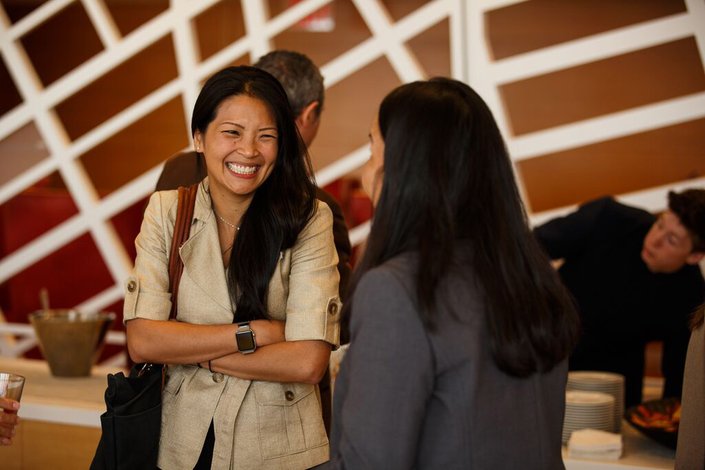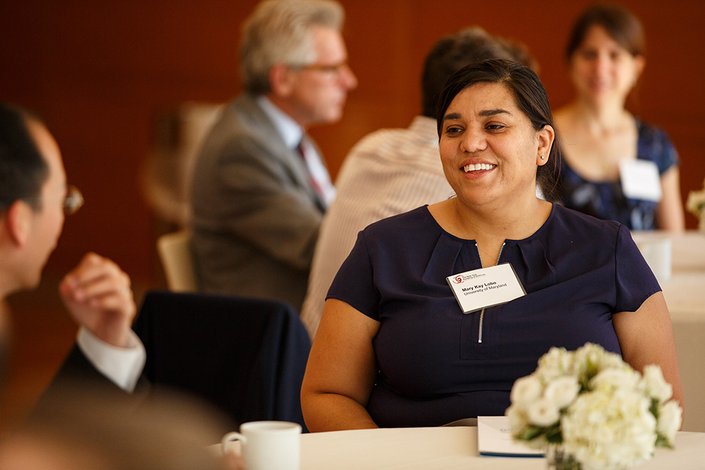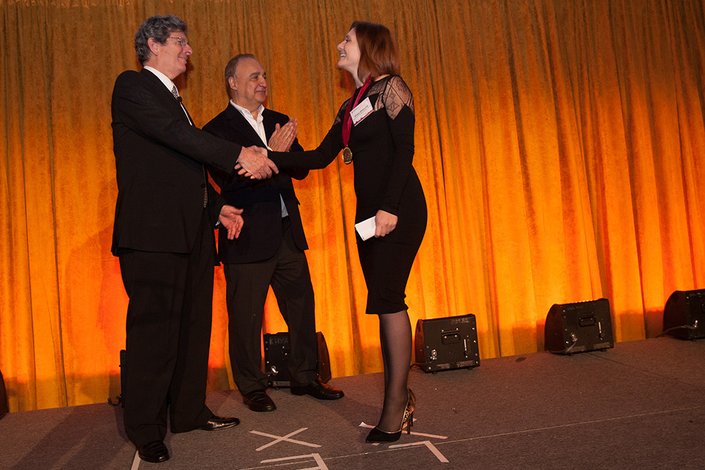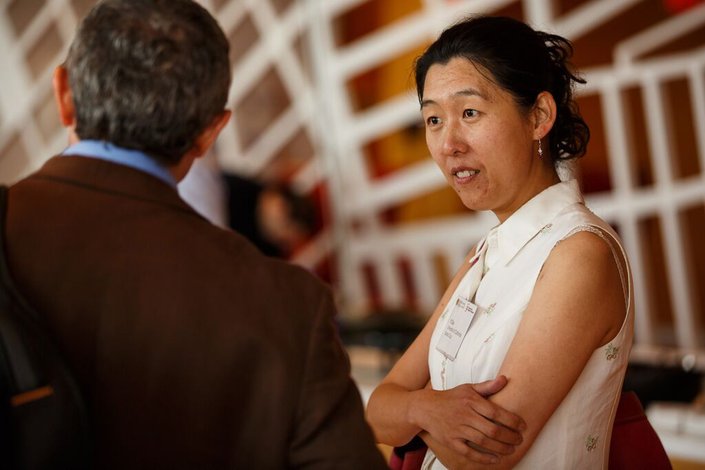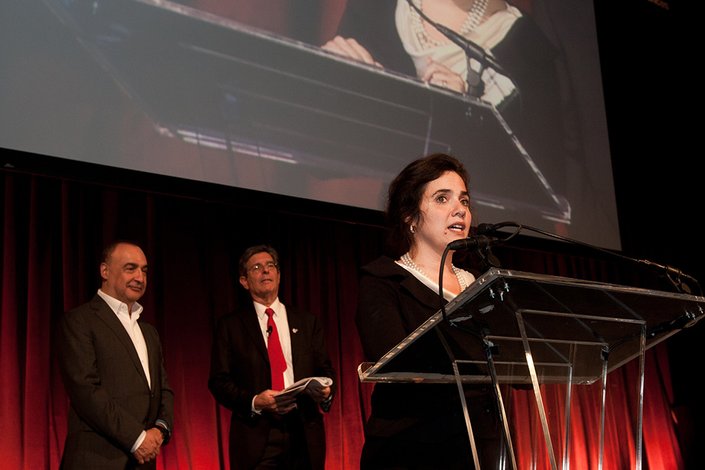
There is no better time to be a woman in the sciences. Generations of advocacy and effort have helped usher more women into diverse scientific fields than ever before, and despite the challenges that remain, today’s women scientists are the largest and most influential cohort in history, their voices louder by the minute.
Ask any of the 34 women winners and finalists of the Blavatnik Awards for Young Scientists and they will readily volunteer that they have the best job in the world. The long years of schooling, competitive atmosphere, tight faculty job market and difficult juggling act between work and family never diminish the joy and excitement that comes through in discussions of their work. For many in the group, becoming a scientist was the dream of a lifetime, even before they had the words to describe it.
Many Paths
For Kathryn Uhrich it began with questions. “I didn’t know I wanted to be a scientist, but I knew I was curious,” the dean of natural and agricultural sciences at the University of California, Riverside recalled of her childhood self. “I wanted to know how everything worked. I took everything apart.”
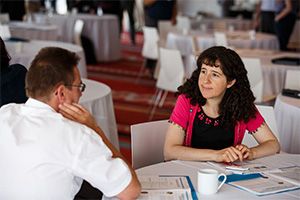 A similar early curiosity found a young Laura Landweber parked at her family’s kitchen table on snow days, immersed in an anatomy coloring book or building models. One winter, without a hint of prescience, she painted a model of a paramecium—a ciliate from the same group as the organism on which Landweber’s groundbreaking work in molecular evolution is based.
A similar early curiosity found a young Laura Landweber parked at her family’s kitchen table on snow days, immersed in an anatomy coloring book or building models. One winter, without a hint of prescience, she painted a model of a paramecium—a ciliate from the same group as the organism on which Landweber’s groundbreaking work in molecular evolution is based.
The notion that this kind of questioning, probing, assembling and even destroying are all central to the scientific endeavor didn’t register until later, most often when elementary or middle school science teachers noticed an aptitude for the subject. By the time particle physicist Mariangela Lisanti was in the eighth grade, she knew where her interests lay, even if she was still honing her experimental skills. “My science fair project that year was an investigation of whether microwaves killed or damaged corn seeds,” she remembers fondly. “I knew they did, but I was trying to find out how much they could take before their growth was stunted, and at what point they died. I grew all these corn seeds and literally covered my parents’ dining room table with petri dishes.” With a reassuring laugh, she adds that the following year’s project investigated how to protect those same seeds.
Sometimes a knack for science exists among other talents, and while it’s hard to imagine microbiologist Christine Jacobs-Wagner as anything but a scientist, it wasn’t her first career choice. At a university open house during her final year of high school, she made a beeline for the law department. “I sat through exactly one class and that was it—I didn’t want to be a lawyer,” she says. “I had to pick a major, and even though I was really interested in business, I picked science because my favorite high school classes were biology and chemistry. I’m a scientist because of those teachers, they really had a tremendous influence on me.”
Discovering a love of science and a natural gift for the academic skills the field requires, whether it’s math, biology, statistics or chemistry, is only the first step. Even before the long road of advanced degrees, there is a choice: which field of science beckons the loudest? Daphne Bavelier, a cognitive neuroscientist whose work on brain plasticity has upended many traditional conventions of how learning takes place, started out pursuing molecular biology. At an internship in her third year of undergraduate work, during her first real hands-on molecular biology experiments, she had what she describes as “a real halt, a moment of ‘wait, what am I doing?” She was surprised that a field that thrilled her in books felt less exciting in real life. “I discovered it was more fun to read about Western blots than to do them,” she remembers,” and thankfully this all happened at a time when there was a revolution in our understanding of brain science. I was fascinated by that, and even though my field didn’t exist yet, that all changed quickly.”
The Road Ahead
Bavelier was fortunate to land in the lab of trailblazing psychologist Molly Potter, one of the first women to join the faculty at the Massachusetts Institute of Technology back in the 1960s, a time when many of the school’s buildings had no women’s restrooms. Potter wasn’t just one of Bavelier’s most influential scientific mentors and advisers, she epitomized a quality crucial to the success of any scientist, regardless of gender: determination.
Today’s academic climate insists that faculty scientists wear many hats—grant writer, teacher, researcher, and sometimes even politician. Add in the pressure to “publish or perish,” and it’s not hard to see why biological engineer Antje Baeumner, tells her students, “if you want the easy route, don’t get a PhD.” Choosing a life in academia means following the work you love the most into an environment that tests even the brightest and most confident, with the specter of rejection never far from mind. Whether it’s being turned down for a grant or having a paper rejected for publication, a life in science means learning to accept no for an answer. What separates the highest achievers seems to be the ability to balance the short-term difficulties with the promise of bigger-picture goals.
“We just had a grant rejected last night and a paper rejected this morning. But that’s just 5 percent of the time. The other 95 percent of the time I’m thrilled. No matter what you do or how you do it, there will be difficulties, so you may as well do what you enjoy.” -- Kathryn Uhrich
The subject of rejection brings up a particular set of issues for women scientists, many of whom approach the topic, and the perceived differences in how men and women process the experience, with an analytical precision befitting their occupation. Many have acknowledged that for women, who represent less than 25 percent of all science faculty in the country, being rejected or overlooked can have larger resonance, and the impacts can be more detrimental.
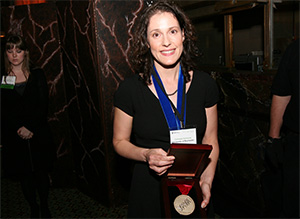 “If you look at the culture of promotion and tenure, it really preys on insecurity,” says geologist Carmala Garzione. “You feel like your work is being evaluated until someone gives you the final nod and says ‘you’re good enough, you can stay.’ Garzione suspects that many women are hampered by notions of how they should behave in a tough competitive environment—they may not see their voices as equal. “These perceptions feed women’s doubts in their ability to succeed,” she says. “I tell my students to worry less-- keep their heads down, get their work done, and do what they love.”
“If you look at the culture of promotion and tenure, it really preys on insecurity,” says geologist Carmala Garzione. “You feel like your work is being evaluated until someone gives you the final nod and says ‘you’re good enough, you can stay.’ Garzione suspects that many women are hampered by notions of how they should behave in a tough competitive environment—they may not see their voices as equal. “These perceptions feed women’s doubts in their ability to succeed,” she says. “I tell my students to worry less-- keep their heads down, get their work done, and do what they love.”
Christine Jacobs-Wagner posits that perhaps one reason men in science seem to push past insecurities and setbacks seemingly more easily than she and other female colleagues do in the early days of their careers is that societal norms present men with more opportunities to face rejection early in life. She calls to mind the typical roles of courtship, explaining, “this has been going on forever—both men and women flirt, but the men propose. The norm is the man in control, and men experience a ton of rejection in this area. If that’s what builds confidence, then maybe we can learn more from being rejected, maybe it can’t be such a big deal.”
 Gender roles never factored into Daniela Schiller’s process of becoming a neuroscientist. As a child growing up in Israel, she knew she would someday serve in the Army, and as she describes it, “over the years I played the drums and parachuted and did a lot of things typically considered masculine. At one point, I wondered why. But I realized it’s not about male or female ability, it’s about choosing the human experience you wish to have. For me, I think it helps to not consider gender, and to just do it, no matter how hard it is.”
Gender roles never factored into Daniela Schiller’s process of becoming a neuroscientist. As a child growing up in Israel, she knew she would someday serve in the Army, and as she describes it, “over the years I played the drums and parachuted and did a lot of things typically considered masculine. At one point, I wondered why. But I realized it’s not about male or female ability, it’s about choosing the human experience you wish to have. For me, I think it helps to not consider gender, and to just do it, no matter how hard it is.”
Refrains of justdo it, keep trying, never give up, take it as far as you can are constant mantras for this group of elite women, and it’s advice that they never hesitate to share with their peers and students. Cell biologist Agnel Sfeir’s passion for her field survived the difficulties of growing up amid the Lebanese Civil War, and her determination remains undiminished today. “If you love science, you have to take it all the way to the end. There’s nothing more rewarding than having your own lab. This is the ultimate. It’s tough, but it’s doable, and there are plenty of women doing it.”
The Best Life
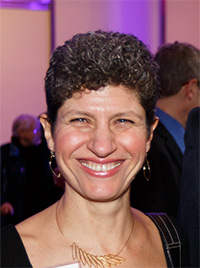 For electrical engineer Elza Erkip, the best job in the world is one that allows her to pursue her passion--these days, much of her research is in wireless networking—as well as have the flexibility to make her own hours, spend time with her two young daughters, present her research at major conferences, and mentor her students. It’s the job she has, and she can’t imagine any other life.
For electrical engineer Elza Erkip, the best job in the world is one that allows her to pursue her passion--these days, much of her research is in wireless networking—as well as have the flexibility to make her own hours, spend time with her two young daughters, present her research at major conferences, and mentor her students. It’s the job she has, and she can’t imagine any other life.
“Some women decide that the juggle of life after a PhD is just too much. But a faculty position is actually the best job for a woman to have a career and a family. Why is this still a secret?” she exclaimed. “I’m so flexible, and there’s nothing else like it. The hard part is getting here, but once you’re here, it’s the best.”
“Getting here” is unquestionably a different journey for men and women—if it weren’t, it’s possible that the stubbornly low rate of women scientists applying for faculty positions would rise. The simple and, at times, frustrating math that causes two major paths in many women scientists’ lives—their childbearing years and their work toward tenure—to intersect, is one major factor that lures some away from academia in favor of industry.
Erkip doesn’t deny the challenges, but she is determined to be living proof that they can be overcome. “Part of the problem is perception, and part of it is having more role models. One of my students got pregnant just as she was about to finish her PhD, and she told me that she looked at me and my family and knew that she could do it, too.”
But what has become a dream career for Erkip and many of her peers still suffers from what is ultimately a marketing problem. Kathryn Uhrich sees most of her doctoral students accept industry jobs, and she and others at her level find themselves working harder to promote the best aspects of faculty science to the next generation. “I try to share my excitement—who wouldn’t want a job where you get paid to play detective, to try to figure out how nature works. I can’t imagine a better job and I tell that to my students,” said Christine Jacobs-Wagner. “I tell them that we all get rejected—I get slapped in the face all the time—and if we take it a little bit personally, which is natural, it only makes the quality of our science better.” Daphne Bavelier echoes similar sentiments with the students she mentors, striving to show that the benefits of a career in science are too rich to ignore.
“It doesn’t matter where you work, balancing work and family is never simple—but the flexibility and the rewards of committing to science are so great, I have to show them it’s worth accepting the difficult parts.” -- Daphne Bavelier
Certainly institutional change will help—and many universities boast growing rosters of women in faculty positions, particularly at untenured ranks. Established senior women scientists acknowledge that more systemic change will take a generation. “As a tenured woman in science, I’m definitely a role model for my students,” said Laura Landweber, “But especially as a full professor at a small place like Princeton, with few senior women in science relative to competitor institutions, you might find yourself the only woman at that rank in your department. And then there’s another gender imbalance if the leaders in the department have had their PhDs for 50 years and you’ve had yours for 15.” Landweber, who is about to move to Columbia University after more than two decades at Princeton, adds that “a mid-career move can bring refreshing and exhilarating change. Plus, the opportunity to be recruited as a senior colleague means that there is no more glass ceiling.”
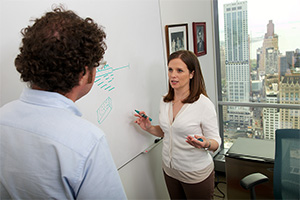 The postdocs and new faculty who will become the deans and department heads of the future seem to be taking the messages of their mentors to heart, and many of these new faculty are having refreshingly positive early days on the job. After just six months at Vanderbilt, biochemist Emily Hodges reports that she feels she’s already being given her share of voice. “I have to give my colleagues a lot of credit—it’s been very encouraging and I’m already being put on committees,” she said. “You’d have to be blind not to see that there are fewer women, but I’m finding opportunities to become a leader.”
The postdocs and new faculty who will become the deans and department heads of the future seem to be taking the messages of their mentors to heart, and many of these new faculty are having refreshingly positive early days on the job. After just six months at Vanderbilt, biochemist Emily Hodges reports that she feels she’s already being given her share of voice. “I have to give my colleagues a lot of credit—it’s been very encouraging and I’m already being put on committees,” she said. “You’d have to be blind not to see that there are fewer women, but I’m finding opportunities to become a leader.”
Hodges and her contemporaries, just like the generations of women scientists that have preceded them, are shattering misconceptions and creating new paradigms for women in the sciences. Unlike their predecessors, however, they are benefitting from cultural shifts that they hope will bring greater equality to their work. They are fearless boundary-breakers, agents of change. They are living the best advice Elza Erkip gives to her young women students. “We cannot be afraid of what’s hard,” she says. “Love what you’re doing and you will succeed.”
